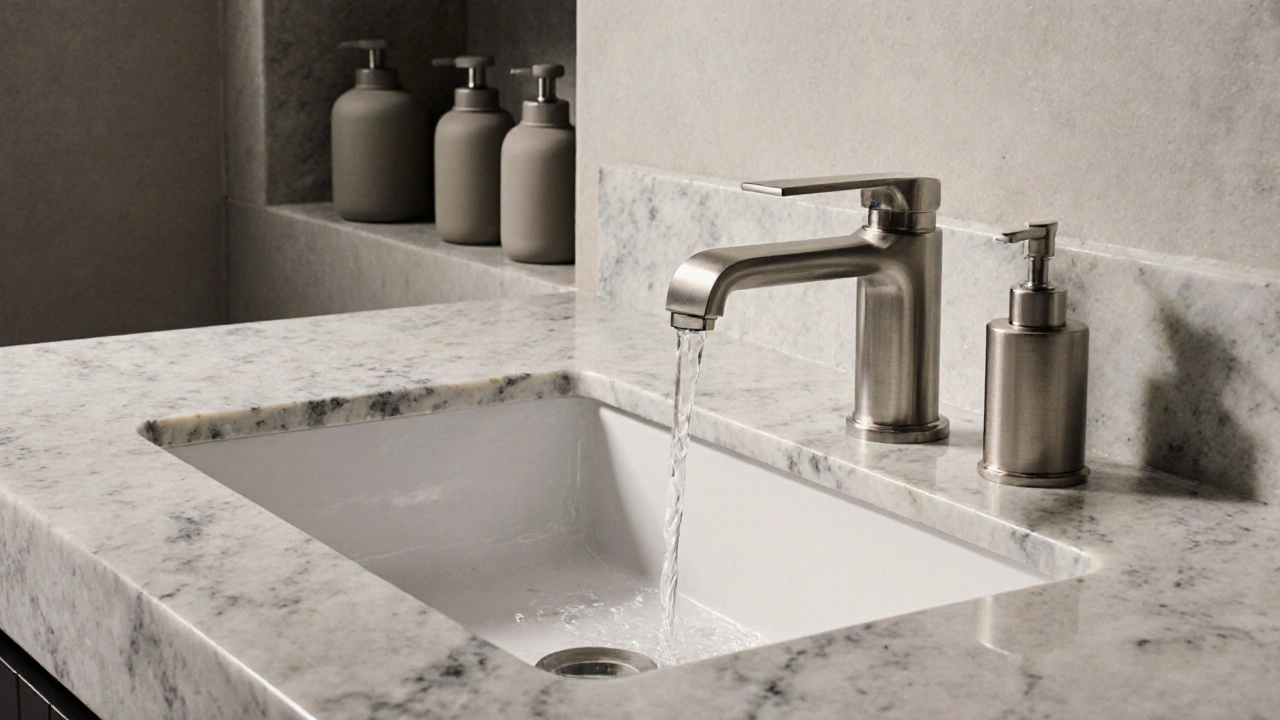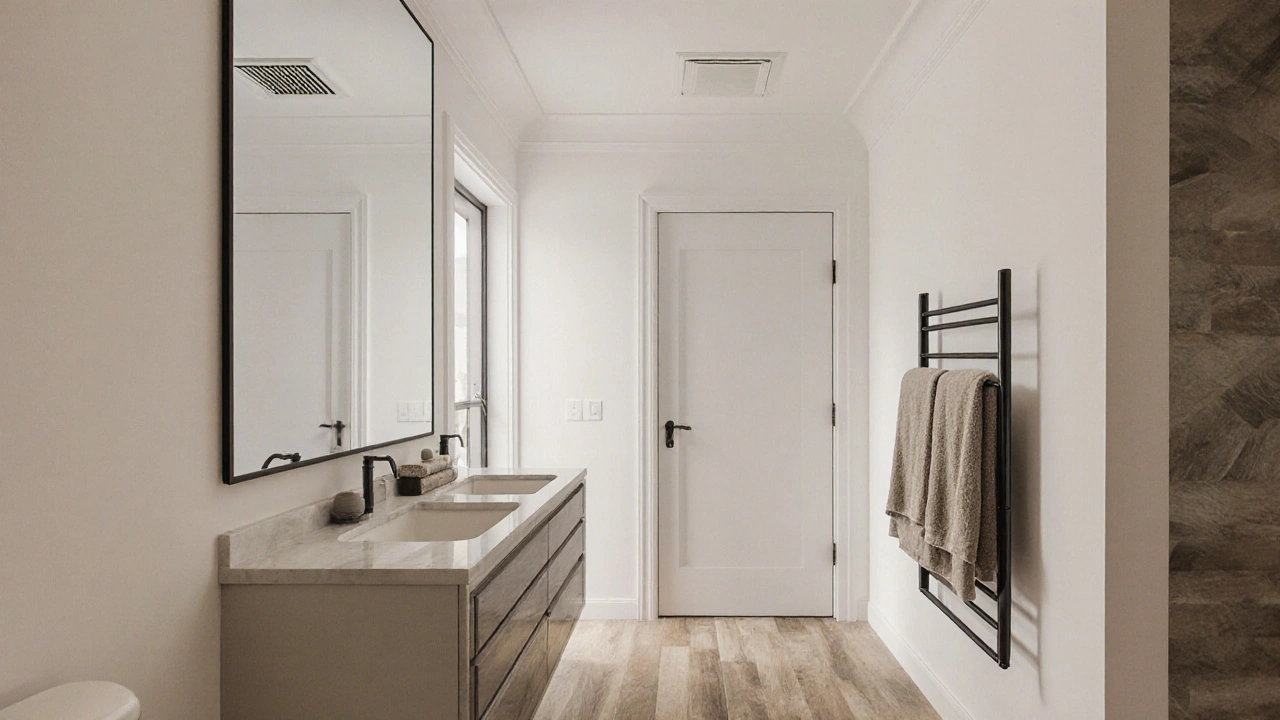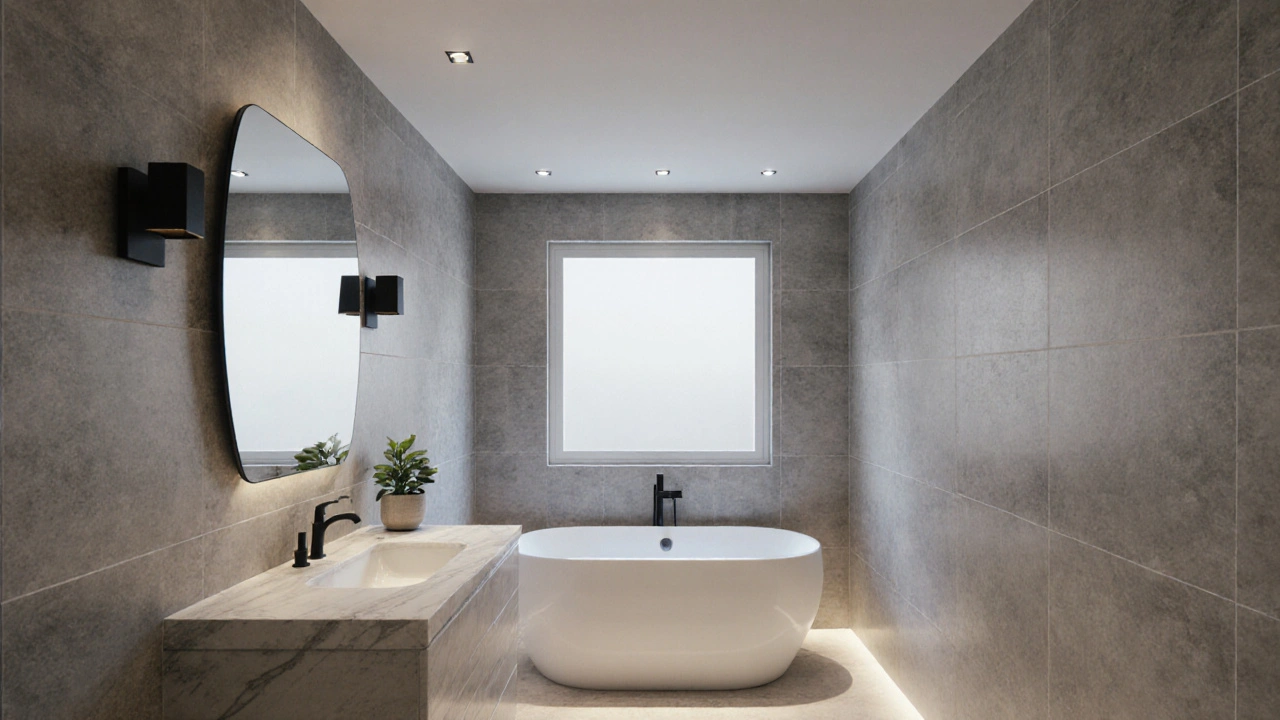Think a classy bathroom means marble counters, gold fixtures, and a soaking tub? You’re not wrong-but you’re also missing the point. The most elegant bathrooms don’t scream luxury. They whisper it. They feel calm. They work. They last. And they don’t cost a fortune if you know where to focus.
It’s Not About Price, It’s About Precision
A $50,000 bathroom can look cheap. A $5,000 one can look timeless. The difference? Intent. Classy bathrooms are built with restraint. They don’t cram in every trend from Pinterest. They pick one or two strong elements and let them breathe.
Take lighting. Most people install one ceiling light and call it done. A classy bathroom uses layered lighting: ambient, task, and accent. Recessed ceiling lights for general glow. Sconces flanking the mirror at eye level to eliminate shadows. A dimmable LED strip under the vanity to create a soft halo. That’s not expensive. It’s thoughtful.
Same with tile. Large-format porcelain tiles-12x24 inches or bigger-make a space feel more open and intentional. Small, busy tiles (like 4x4 subway tiles in a herringbone pattern) look dated. They create visual noise. Big tiles mean fewer grout lines. Fewer grout lines mean less cleaning. Less cleaning means less stress. That’s class.
Color Is Your Silent Partner
White bathrooms aren’t boring. They’re confident. The most enduringly classy bathrooms use neutral palettes: warm whites, soft grays, muted beiges. These colors don’t date. They don’t clash. They let the materials speak.
Don’t mistake neutral for flat. Add depth with texture. A matte black faucet against a honed marble vanity. A woven basket next to a smooth porcelain tub. A fluted glass shower door that catches light differently than a clear one. Texture is the secret ingredient in every high-end design magazine. It’s what makes a space feel rich without being loud.
And avoid the all-white trap. Pure white walls and fixtures look clinical. Use a warm white-like Benjamin Moore’s White Dove or Sherwin-Williams’ Alabaster. These have a hint of cream or gray that keeps things soft. Add a single dark accent: a charcoal towel bar, a black-framed mirror, or even dark grout. That contrast is what makes the space feel intentional, not sterile.
Fixtures Don’t Need to Shine-They Need to Feel Right
Gold hardware is everywhere. But brushed nickel, matte black, and unlacquered brass are the quiet winners now. Why? They age gracefully. Gold shows fingerprints and water spots like a billboard. Matte finishes hide them. Unlacquered brass develops a patina over time-darkening slightly, getting richer. That’s not a flaw. That’s character.
Look at faucets. A single-handle, wall-mounted faucet with a long, graceful spout looks more expensive than a traditional two-handle model. It’s cleaner. Less clutter. And it works better with vessel sinks or deep basins. You don’t need a $2,000 faucet. A $400 one from a brand like Kohler or Delta with a solid brass core and ceramic valve will outlast cheaper models and feel more substantial in your hand.
Showerheads matter too. A fixed rain showerhead paired with a handheld on a slide bar gives you flexibility without clutter. No more wrestling with a hose that falls off the wall. That’s not luxury. That’s smart design.

Storage That Disappears
Clutter kills elegance. A classy bathroom hides everything. No open shelves with toothpaste tubes and hair dryers. No plastic bins under the sink.
Use recessed niches in the shower for shampoo and soap. They’re built into the wall, so they don’t stick out. Install medicine cabinets with mirrored doors that blend into the wall. Choose vanities with soft-close drawers and no visible handles-push-to-open mechanisms are now affordable and sleek.
Even towels should be stored out of sight. A heated towel rack does double duty: keeps towels warm and tucked away. Or install a linen closet next to the bathroom. If you must show towels, fold them neatly and limit them to three colors max. No rainbow patterns.
Materials That Last
Classy bathrooms don’t use cheap materials that chip, fade, or stain. They use things built to last.
Porcelain tile over ceramic. It’s denser, less porous, and resists scratches. Natural stone like travertine or slate is beautiful-but only if sealed properly and maintained. For floors, avoid glossy finishes. They turn into ice rinks when wet. Matte or textured finishes are safer and look more grounded.
Countertops? Solid surface materials like quartz are the smart choice. They look like marble but don’t need sealing. They resist stains from toothpaste, makeup, and hair dye. Granite is fine too, but it’s heavier and harder to install. Avoid laminate. Even the best-looking laminate looks fake up close.
And don’t forget the ceiling. Most people ignore it. A painted ceiling in the same color as the walls makes the room feel taller. Add a simple crown molding in white or wood tone-it’s subtle, but it ties the room together.

The Little Things That Make All the Difference
Classy details aren’t grand. They’re quiet. They’re the things you notice after you’ve lived there for a week.
- A heated floor underfoot in the morning-just enough to take the chill off. Not a luxury. A necessity in a well-designed space.
- A towel warmer that doubles as a radiator in winter.
- A vent fan that’s whisper-quiet and runs automatically when humidity rises. No more foggy mirrors.
- A single, well-placed plant-a snake plant or ZZ plant-in a ceramic pot. It adds life without clutter.
- A soap dispenser that matches your faucet. Not a plastic bottle from the drugstore.
These aren’t expensive. But they’re intentional. And intention is what separates a bathroom that looks expensive from one that feels expensive.
What to Skip (Seriously)
Here’s what never looks classy:
- Colored grout. It stains. It looks messy. Stick to gray or white.
- Overly ornate mirrors. A simple frameless mirror or one with a thin metal edge is cleaner.
- Too many patterns. No floral wallpaper. No geometric tiles on the floor and walls. Pick one focal point.
- Plastic shower curtains. Use a glass door or a fabric liner that looks like linen.
- Overly trendy lighting. That giant chandelier over the tub? It’s a photo op, not a lifestyle.
Classy doesn’t mean loud. It means quiet confidence.
Final Thought: It’s About How It Feels
A bathroom isn’t a showroom. It’s a sanctuary. The most classy ones don’t impress guests-they comfort you. They make your morning routine feel like a ritual, not a rush. They make you feel calm, clean, and in control.
That’s not about spending more. It’s about thinking more.
Can you make a small bathroom look classy?
Absolutely. Small bathrooms benefit most from smart design. Use large-format tiles to minimize grout lines and create the illusion of space. Install a wall-mounted vanity to free up floor space. Use mirrors strategically-full-height mirrors reflect light and make the room feel larger. Stick to a neutral palette and avoid busy patterns. Even a tiny bathroom can feel luxurious with the right lighting and hidden storage.
Is marble still a good choice for a classy bathroom?
Marble has a timeless appeal, but it’s high-maintenance. It stains easily from toothpaste, makeup, and even hard water. If you want marble, go for honed (not polished) finishes-they hide etching better. Or consider high-quality quartz that mimics marble’s look without the upkeep. Many homeowners now choose quartz for its durability and consistent appearance.
What’s the best flooring for a bathroom that looks classy?
Large-format porcelain tile is the top choice. It’s water-resistant, durable, and comes in finishes that mimic stone, wood, or concrete. Avoid glossy tiles-they’re slippery when wet. Opt for matte or textured finishes. Heated floors add comfort and elevate the feel without looking flashy. Wood-look porcelain is especially popular now because it brings warmth without the risk of warping.
Should I install a bathtub in a classy bathroom?
Only if you use it. Many modern bathrooms skip the tub entirely and go with a large walk-in shower. That’s fine-if you don’t soak. But if you enjoy baths, a freestanding tub can be a stunning focal point. Choose a simple, sculptural design in acrylic or cast iron. Avoid clawfoot tubs unless you’re going for a full vintage look. A clean-lined tub in white or black reads as modern and luxurious.
How important is ventilation in a classy bathroom?
Critical. A bathroom that smells musty or has foggy mirrors doesn’t feel classy-it feels neglected. Install a quiet, powerful vent fan that turns on automatically with humidity. Make sure it vents to the outside, not the attic. A good fan costs under $200 and pays for itself by preventing mold and damage. Don’t skip this. It’s the invisible foundation of a well-maintained space.



Vimal Kumar
November 5, 2025 AT 18:23Big tiles and matte black fixtures changed my tiny bathroom from a nightmare to a zen zone. No more scrubbing grout every week. Just wipe and go. I didn’t spend a fortune but it feels like a spa now.
Amit Umarani
November 6, 2025 AT 02:49You said "classy" but used "marble" like it’s a virtue. Real talk: marble stains from toothpaste. You’re glorifying maintenance hell. Quartz is the adult choice.
Noel Dhiraj
November 7, 2025 AT 09:02Heated floors are a game changer dont even sleep on it. Waking up to warm tiles in winter is basically a hug from your house. Also ditch the plastic soap bottle. A matching dispenser makes it feel like you live in a magazine even if you just ate cereal in your pajamas
vidhi patel
November 8, 2025 AT 02:18It is deeply concerning that you suggest using "warm white" as if it is an objective design principle. This is not a suggestion; it is a dangerous aesthetic compromise. Benjamin Moore White Dove is not a neutral-it is a deceptive illusion of neutrality that introduces chromatic bias into a space that should be purely functional. You are promoting emotional manipulation through color theory, which is intellectually dishonest.
Priti Yadav
November 9, 2025 AT 17:28They’re watching you through your bathroom mirror. The camera behind the glass is how they track your habits. That "whisper-quiet" vent fan? It’s not just removing moisture-it’s recording your voice. And those "hidden" storage drawers? They’re listening. They want you to think this is about class. It’s about control.
Ajit Kumar
November 11, 2025 AT 14:04Let me be perfectly clear: the notion that a $5,000 bathroom can be as "timeless" as a $50,000 one is not only misleading, it is fundamentally flawed. Timelessness is not a function of restraint-it is a function of material integrity, craftsmanship, and proven durability over decades. Porcelain tile may be affordable, but it lacks the thermal mass, the patina, the historical resonance of natural stone. You are equating cost-efficiency with elegance, which is a category error of the highest order. A bathroom that does not age gracefully is not classy-it is merely economical, and economy is the antithesis of true refinement.
Diwakar Pandey
November 13, 2025 AT 03:05Just did the bathroom overhaul last month. Went with large-format porcelain, matte black faucet, and a single plant by the sink. No fancy lights. No mirrors with frames. Just quiet. And honestly? It’s the first space in my house where I actually pause. Not because it looks expensive. Because it doesn’t scream. Just breathes.
Geet Ramchandani
November 14, 2025 AT 10:18Let’s be real-this whole "classy bathroom" trend is just middle-class performative minimalism. You’re not creating a sanctuary-you’re performing austerity as luxury. That "hidden storage"? You’re just hiding your mess because you can’t afford to buy enough towels or real soap. And don’t even get me started on the "unlacquered brass"-it’s just tarnish you’re romanticizing because you’re too lazy to polish it. This isn’t design. It’s guilt-tripping yourself into thinking you’re sophisticated while still using a $3 shower curtain from Target.
Pooja Kalra
November 15, 2025 AT 00:50Class is not in the tile or the faucet. It is in the silence between the moments. The bathroom is not a stage. It is a mirror of the self. To seek elegance in materials is to misunderstand the nature of beauty. True refinement is the absence of need-not the presence of design. The quietest bathrooms are the ones that ask nothing of you. And perhaps, that is the only luxury that remains untouched by time.